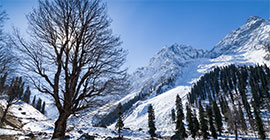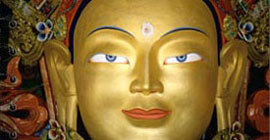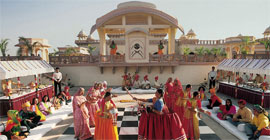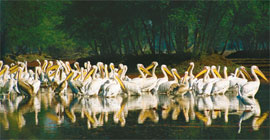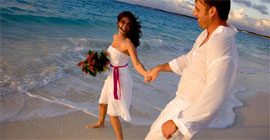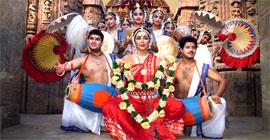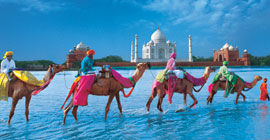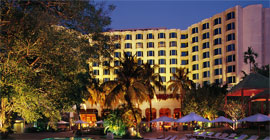Mumbai
Home | Mumbai
Mumbai, formerly Bombay, is the capital of the Indian state of Maharashtra and the financial capital of India. With an estimated population of thirteen million, it is the most populous city in India and the second most populous city in the world. Along with the neighbouring suburbs of Navi Mumbai and Thane, it forms, at nineteen million, the world's fifth most populous metropolitan area. Mumbai lies on the west coast of India and has a deep natural harbour. Mumbai's port handles over half of India's maritime cargo.
History
The Haji Ali Mosque was built in 1431, when Mumbai was under Islamic rule History of Mumbai
Artifacts found near Kandivali in northern Mumbai indicate that these islands had been inhabited since the Stone Age. Documented evidence of human habitation dates back to 250 BCE, when it was known as Heptanesia (Ptolemy) (Ancient Greek: A Cluster of Seven Islands). In the 3rd century BCE, the islands formed part of the Maurya Empire, ruled by the Buddhist emperor, Asoka. During its first few centuries, control over Mumbai was disputed between the Indo-Scythian Western Satraps and the Satavahanas. The Hindu rulers of the Silhara Dynasty later governed the islands until 1343, when the kingdom of Gujarat annexed them. Some of the oldest edifices of the archipelago – the Elephanta Caves and the Walkeshwar temple complex date from this era.
In 1534, the Portuguese appropriated the islands from Bahadur Shah of Gujarat. They were ceded to Charles II of England in 1661, as dowry for Catherine de Braganza. These islands, were in turn leased to the British East India Company in 1668 for a sum of £10 per annum. The company found the deep harbour on the east coast of the islands to be ideal for setting up their first port in the sub-continent. The population quickly rose from 10,000 in 1661, to 60,000 in 1675; In 1687, the British East India Company transferred its headquarters from Surat to Mumbai. The city eventually became the headquarters of the Bombay Presidency.
The Gateway of India was built to commemorate the arrival in India, on 2 December 1911, of King George V and Queen Mary and was completed on 4 December, 1924From 1817 onwards, the city was reshaped with large civil engineering projects aimed at merging all the islands in the archipelago into a single amalgamated mass. This project, known as the Hornby Vellard, was completed by 1845, and resulted in the total area swelling to 438 km². In 1853, India's first passenger railway line was established, connecting Mumbai to the town of Thane. During the American Civil War (1861–1865), the city became the world's chief cotton trading market, resulting in a boom in the economy and subsequently enhancing the city's stature.
The opening of the Suez Canal in 1869 transformed Bombay into one of the largest seaports on the Arabian Sea. Over the next thirty years, the city grew into a major urban centre, spurred by an improvement in infrastructure and the construction of many of the city's institutions. The population of the city swelled to one million by 1906, making it the second largest in India after Calcutta. As capital of the Bombay Presidency, it was a major base for the Indian independence movement, with the Quit India Movement called by Mahatma Gandhi in 1942 being its most rubric event. After India's independence in 1947, it became the capital of Bombay State. In the 1950 the city expanded to its present limits by incorporating parts of Salsette island which lay to the north.
After 1955, when the State of Bombay was being re-organised along linguistic lines into the states of Maharashtra and Gujarat, there was a demand that the city be constituted as an autonomous city-state. However, the Samyukta Maharashtra movement opposed this, and insisted that Mumbai be declared the capital of Maharashtra. Following protests in which 105 people were killed by police firing, Maharashtra state was formed with Mumbai as its capital on May 1, 1960.
Flora Fountain was renamed Hutatma Chowk ("Martyr's Square") as a memorial to the Samyukta Maharashtra movementThe late 1970s witnessed a construction boom and a significant influx of migrants, which saw Mumbai overtake Kolkata as India's most populous city. This influx caused unrest among local Maharashtrians who worried about the loss of culture, jobs, and language. The Shiv Sena Party was formed by Bal Thackeray for the purpose of securing the interests of Maharashtrians. The city's secular fabric was torn apart in the riots of 1992–93, after large scale sectarian violence caused extensive loss of life and property. A few months later, on March 12, a series of co-ordinated bombings at several city landmarks by the Mumbai underworld killed around three hundred people. In 1995, the city was renamed Mumbai by the Shiv Sena government of Maharashtra, in keeping with their policy of renaming colonial institutions after historic local appellations. There have also been terrorist attacks, sponsored by Islamic extremists, on public transport buses in past years. In 2006, Mumbai was also the site of a major terrorist attack in which over two hundred people were killed when several bombs exploded almost simultaneously on the Mumbai Suburban Railway.
Geography
The metropolis consists of the Mumbai city, Mumbai suburban district and also the cities of Navi Mumbai and Thane Geography of Mumbai
Mumbai lies at the mouth of the Ulhas River off the western coast of India, in the coastal region known as the Konkan. It sits on Salsette Island, partially shared with the district of Thane. Much of the city lies just above sea level, with average elevations ranging from 10 m (33 ft) to 15 m (49 ft). Northern Mumbai is hilly, and the highest point in the city is 450 m (1,476 ft). The city spans a total area of 603 km² (233 sq mi).
Sanjay Gandhi National Park is located near to the city, and covers almost 1/6th of the city area. It is to be noted big cats such as panthers are still residing in this national park next to millions of people in an age of habitat shrinkage and species extinction.
Apart from the Bhatsa Dam, six major lakes supply water to the city: Vihar, Vaitarna, Upper Vaitarna, Tulsi, Tansa and Powai. Tulsi Lake and Vihar Lake are located in Borivili National Park, within the city's metropolitan limits. The supply from Powai lake, also within the city limits, is used only for industrial purposes. Three small rivers, the Dahisar, Poinsar (or Poisar) and Ohiwara (or Oshiwara) originate within the park, while the now infamous Mithi River originates from Tulsi Lake and gathers water overflowing from Vihar and Powai Lakes. The coastline of the city is indented with numerous creeks and bays. The eastern coast of Salsette Island is covered with large mangrove swamps, rich in biodiversity. The western coast is mostly sandy and rocky.
Soil cover in the city region is predominantly sandy due to its proximity to the sea. In the suburbs, the soil cover is largely alluvial and loamy. The underlying rock of the region is composed of black Deccan basalt flows, and their acid and basic variants dating back to the late Cretaceous and early Eocene eras. Mumbai sits on a seismically active zone owing to the presence of three fault lines in the vicinity. The area is classified as a Zone III region, which means an earthquake of up to magnitude 6.5 on the Richter-scale may be expected.
Chowpatty is one of the most famous beaches of Mumbai and a prime spot for Mumbai's roadside cuisine.Contemporary art is well-represented in both government funded art spaces and private commercial galleries. The government-funded art galleries include The Jehangir Art Gallery and The National Gallery of Modern Art. Built in 1833, the Asiatic Society of Bombay is the oldest public library in the city. The Chhatrapati Shivaji Maharaj Vastu Sangrahalaya (formerly The Prince of Wales Museum) is a renowned museum in the heart of South Mumbai near the Gateway of India which houses rare and ancient exhibits of Indian history.50 Mumbai has a very popular zoo named Jijamata Udyaan which also harbours a garden within its boundaries.51 The city of Mumbai is home to many well known Indian poets.
Mumbai has two UNESCO World Heritage Sites, the Chhatrapati Shivaji Terminus and the Elephanta Caves.52 The Western Railways is also planning to make a proposal to the UNESCO to include the Churchgate building in the list of World Heritage Sites.53 Popular places in the city are Nariman Point, Girgaum Chowpatti, Juhu Beach, and Marine Drive. Essel World54 is an international-style theme park and amusement centre situated close to Gorai Beach. Asia's largest theme water park, Water Kingdom, is also located in Mumbai.
Mumbai residents celebrate Western and Indian festivals with great fanfare. Diwali, Holi, Christmas, Navratri, Good Friday, Dussera, Moharram, Ganesh Chaturthi, Durga Puja and Maha Shivratri are some of the popular festivals in the city. The Kala Ghoda Festival is an exhibition of a world of arts that encapsulates works of artistes in the fields of music, dance, theater, and films. A week long fair known as Bandra Fair or Mount Mary Festival is celebrated by people of all faiths. The Banganga Festival is a two-day music festival, held annually in the month of January, which is organised by the Maharashtra Tourism Development Corporation (MTDC) at the historic Banganga Tank in Mumbai.56 The Elephanta Festival which is celebrated every February on the Elephanta Islands, is dedicated to the classical Indian Dance and Music with artists from across the country arriving on the island.







